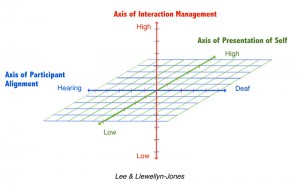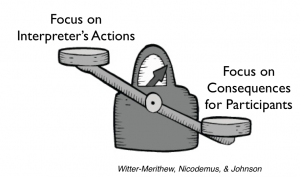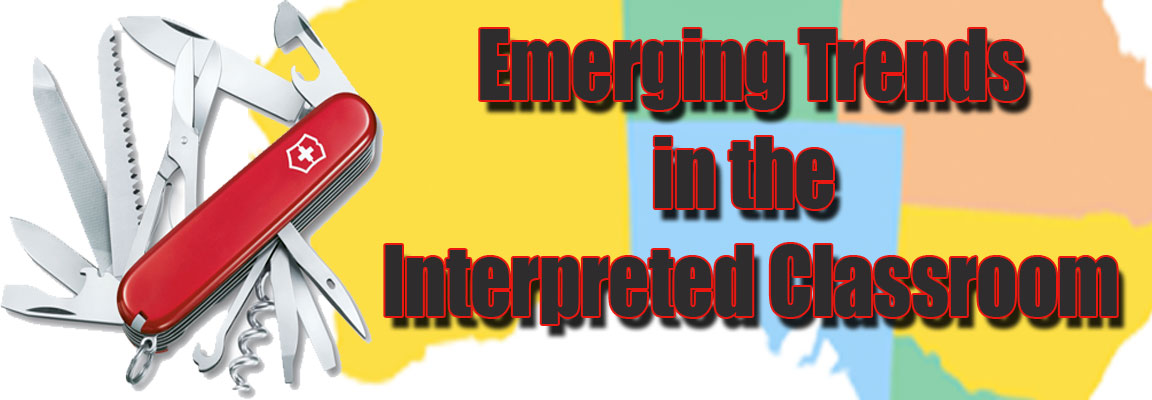
1 February 2017
Adelaide, South Australia
A new paradigm for interpreters working in the classroom is emerging in the United States. This workshop will look at research into trends in interpreter education and theoretical frameworks underpinning best practices. We will discuss how what is taking place in the US applies to educational teams in South Australia.
Workshop Presentation & Handout
Click the buttons below to view resources from the presentation.
Workshop Resources
Workshop Resources
Each of the titles in the list below is a link. When you click on the title, it will reveal a series of resources contained in that category.
Emerging Paradigm Resources
Educational Interpreting
Resources Related to Educational Interpreting
The National Association of Interpreters in Education

The National Association of Interpreters in Education (NAIE) is a professional organization for interpreters in educational settings established in 2016. http://naiedu.org/
 More than Meets the Eye: Revealing the Complexities of an Interpreted Education
More than Meets the Eye: Revealing the Complexities of an Interpreted Education
by Melissa B. Smith
http://gupress.gallaudet.edu/bookpage/MTMEbookpage.html
View the Ph.D. Dissertation this book is based on here.
Dr. Smith did a lecture at Gallaudet University on this topic.
You can see all of the presentations archived by Gallaudet University Regional Interpreter Education Center here.
Understanding the Impact of Interpretability in Mainstream Classrooms
This chapter by Betsy Winston lays out the limitations for rigid understandings of interpreting in classroom settings.
Winston, B. 2004. “Interpretability and Accessibility of Mainstream Classrooms,” In Educational Interpreting: How it Can Succeed. Gallaudet University Press. See the article.
Articles about Educational Interpreting
New Paradigms in the Interpreted Classroom: An article written by Doug Bowen-Bailey for the RID Views -(in press August 2014)
Perspectives from Gina Oliva
Dr. Oliva is the author of “Alone in the Mainstream” sharing her experience as an “only” going through mainstreamed settings – as well as some of her research about other deaf people who went through the mainstream in a similar way.
- Sign Language Interpreters in Mainstream Classrooms: Heartbroken and Gagged
An article on Street Leverage. Check it out. - K-12 Interpreters: A Call to Arms for Sign Language Interpreter Programs
An article on StreetLeverage. Check it out.
Determining a Student’s Readiness to Successfully Use Interpreting Services
This is an article from Cindy Huff, a teacher of the Deaf/Hard of Hearing, about a framework for assessing if students are at a developmental level appropriate for benefiting from an interpreted education.
Language Acquisition
The link below has a presentation in ASL about the Common Errors of Young Children Acquiring Sign Language, helpful information in seeing what is normal language development.
Providing Access: New Roles for Educational Interpreters
By Bernhardt E. Jones, Ed.D., C.S.C.
Originally published in the RID VIEWS
Conflicts can, and do, occur when it is unclear as to the interpreter’s role at any given time. This function changes during the day, especially in the lower grades. I am suggesting (as has Winston) that the title, “educational interpreter” is too narrow, and, in fact, this position is a multi-faceted responsibility. If this is true, how do we separate the roles? How do we define what it is that we do and when?
A year ago Winston (Views) did a fine job in delineating educational interpreting responsibilities into three roles: interpreting, tutoring and aiding. Since then, Winston has discussed the notion that consulting is also a role that educational interpreters play. Consulting may be a new area that you had not considered before. But, think about all the times you have given your input in the school situation. How many times have you talked to parents? How many times have you explained “deafness” to others in the school? to students? to administrators? to regular education teachers? You may find that this list is long. Go to the dictionary or, better, go to the Web and search the word, “consulting” or “consultant” and see what you find. Do you fit into this definition during part of the time you are working in the school setting?
The public school educational interpreter is viewed quite often as a paraprofessional and, in fact, is categorized that way in many states. However, we can make the case that, although the interpreter does perform many of the duties of the paraprofessional, she/he also performs a duty that is quite different and requires separate and distinct knowledge and skills: interpreting itself. Are we not, then, more than an educational interpreter? Might we be, to use a term that Winston has expressed, an “Accessibility Specialist?” I don’t want to confuse the issue with additional terms for us, but think about the variety of tasks you perform. Perhaps we are not “just the interpreter,”but we are more than the interpreter.
Take a look at your day (or week or month, if you would like). Make a list of all the duties you perform. Try to think of everything that happens in your job. What do you do? How long do you do it? Make the list as long and comprehensive as you can. You should have a collection of everything you do. You may be surprised to see that you do quite a bit for the school and the students (both deaf/hard of hearing and hearing).
The Windmill Model
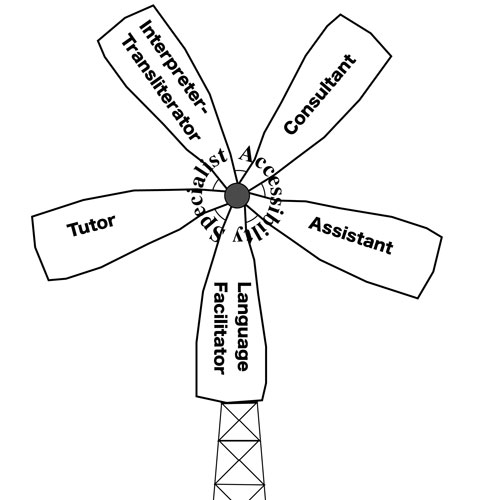
Note: The graphic has been updated since the article was written so it does not perfectly correspond to the article.
The next step is to draw your own windmill and categorize the duties/tasks that you have listed. Interpreting will include anything you do in the role of an interpreter. Tutoring will include all the tasks you do within that context. Aiding is a large and varied area or responsibility. Think of all the things you do in an aiding capacity. As discussed above, consulting is also an important role of the educational interpreter.
Isn’t this appropriate? A windmill spins in the wind and must be flexible (accommodating) in order to operate effectively and efficiently. If one of the blades is broken or damaged, the windmill will not operate properly. Are we like that?
I suggest that we are. With this model we can delineate our roles. When we are able to do that, we can better understand why dilemmas cause conflict. Conflict arises when we are not sure on which blade to categorize our dilemma. We are better able to handle conflict if we know the rules by which to address the conflict. When conflict arises, we know where it fits and, therefore, we know how to respond (how to “spin” our windmill). [I guess it depends upon who is blowing on our windmill.] The blades of the windmill can be viewed as contexts. When we know the contexts, we know the rules. This is where the Code of Ethics has caused us concerns. When applied to the interpreting blade (role, context) of the model, it is easy to understand the importance of the Code and to adhere to its principles. When we apply those same criteria to the other blades (roles), it becomes cloudy and appears to conflict with the role. The problem is compounded if other professionals do not know our contexts and/or confuse our contexts (roles, blades). We then can apply the “educating others about our role(s)” principle of the Code by explaining our contexts and the roles to others on the educational team. The other members of the educational team will not realize this by themselves. We have a professional obligation to educate our fellow professionals. By doing so, we will be viewed as professionals.
This is only the beginning. When we understand which role we are working within, we can start addressing bigger questions in our field. These questions might involve questions of interpretability in the classroom, accessibility to content, an interpreted education. These questions impact our windmill and, therefore services to students who are deaf and hard of hearing.
Information about the Educational Interpreter Performance Assessment
This site provides information both about the test and about the expectations for interpreters working in educational settings. classroominterpreting.org
Guides for Classroom Interpreting for Parents, Professionals, and Students
Dr. Brenda Schick, the co-creator of the EIPA, along with Boys Town, created a series of guides for the Laurent Clerc National Deaf Education Center.
Training in Interpreting Public Schools (TIPS)
TASK12: This is the organization that led to the development of the Training in Public Schools (TIPS) module. The project serves 14 states and provides both training and assessment with the EIPA.
Post-Secondary & Transition Resources:
The Minnesota Transition Guide for Teachers of Deaf/Hard of Hearing was created as a pilot project for the school year 2012 – 2013. It is meant to give guidance in the area of transition for Deaf or Hard of Hearing students. View Transition Guide.
PEPnet: An organization focused assisting Deaf and hard of hearing students in their transition to post-secondary education. They have a module, Map It!, that is designed as a support for students in the transition stages.
Article from 2003 RID Views
Posted in: "Exploring Emerging Paradigms" Resources, "Finding Your Place" Resources, "Part of the Team" Resources, "TIPS-Light" Resources, "Turning on the Light" Resources, Case Conferencing Resources, Emerging Paradigm Resources, In Service to Literacy, Mentoring Resources, Moving toward Best Practice, Sense of Place, Swiss Army Knife Tools
How We Learn
Learning from Cognitive Science and Psychology
For the grant project that I am working with the CATIE Center on, this is a real focus for me now – looking at evidence-based practices for how we actually learn. Here are the two books that I am finding extremely helpful.
Make It Stick: The Science of Successful Learning
by Brown, Roediger, and McDaniel Published in 2014.
This books uses stories to illustrate evidence-based practices that help promote durable learning – that is things that last beyond regurgitating items for a test. Here are some of the principles that help learning last:
- Effective learning is effortful. (If it is easy, you probably won’t remember it for the long-term.)
- Effective learning is spaced out. (Waiting a week and then testing yourself to try to see if you remember the information – using techniques like flash cards to make yourself try to remember – and then checking to see if you did accurately.) It is the trying to remember that actually helps establish the neural pathways which allow you to retrieve information for use.
- Effective learning includes reflection, elaboration, and generation. Reflect: look back on what you studied and think of how it connects with what you already know; elaborate: make connections to other concepts you use and see how the ideas can be tied together into a mental model; and generate: imagine how you would apply the concepts in future scenarios.
- Effective learning uses dynamic assessment. This includes frequent and low-stakes assessment – like quizzes that both help you know where you stand and also force you to try to retrieve information. Research shows that this is much better time spent than re-reading or re-watching texts.
I really suggest that this is a book worth reading – to help you learn some powerful tools – and perhaps even more importantly, to be motivated to try some of these new techniques because research also shows that though they produce good results, people sometimes prefer what is familiar because it feels easier and gives the illusion of knowledge. You might feel like you are learning things more quickly using strategies like re-reading a text – but the reality is that it won’t stick.
Thinking Fast & Slow
by Daniel Kahneman. Published in 2011.
A book for the lay person by an economic psychologist and Nobel Prize laureate, Kahneman lays out many principles of how our brains work that have an impact on the way we learn. He uses a great number of examples for the two systems of our brain:
- System 1: Our automated brain that is the “thinking fast” part of how we deal with the world. This is a system designed to make connections, fit information into a cohesive narrative, and jump to conclusions. It also sometimes fools us and makes serious mistakes because of a number of biases that are built into the process.
- System 2: This is the part of our brain requiring conscious effort and is designed to be a check on system 1. This is the “thinking slow” part.
Kahneman lays out a number of psychological experiments that have demonstrated how these two systems interact and how we sometimes get caught up in thinking errors because we believe we are making decisions solely with our system 2, but that they are often influenced by our system 1.
Posted in: Discourse Mapping, Emerging Paradigm Resources, In Service to Literacy
Theory of Mind
Developing a Theory of Mind
Brenda Schick, in a chapter in the book, Educational Interpreting: How It Can Succeed, explains how the developing of a Theory of Mind (ToM) is related to educational development for students and how that can be impacted by receiving schooling through an interpreter. Theory of Mind is defined by Wikipedia as “the ability to attribute mental states—beliefs, intents, desires, pretending, knowledge, etc.—to oneself and others and to understand that others have beliefs, desires, intentions, and perspectives that are different from one’s own.”
Schick argues that an important part of children developing this ability is to see how people talk about certain topics – recognizing that different people will display different emotions. Receiving information through an interpreter can distort the ability to see/hear how other people are conveying information. Based on the EIPA scores of approximately 1,3000 interpreters, she notes the average prosody score for elementary interpreters was 2.8 for elementary interpreters and 3.0 for secondary interpreters. (Many states recognize 4.0 as an overall score denoting being qualified to work in classrooms.) Schick writes of this situation:
Ironically, elementary-aged deaf and hard of hearing children with hearing families, who are likely to be delayed in their Theory of Mind skills and who are still developing their understanding of how minds work, may have the least amount of information in the classroom interpretation to figure out register and identity of the speaker. (pp 77-78)
Interpreters working with students developing a ToM need to be particularly aware of identifying who is speaking in the classroom and providing information about how someone is talking about the topic and what might be the underlying meaning to the message conveyed by the prosodic nature of the discourse. Schick gives the example of a teacher “issuing a warning to finish seatwork by saying ‘It’s getting close to reeecceeesss,’ meaning ‘you may not get to go out if you don’t finish.'” Note that in this example, the teacher’s pronunciation of the word “recess” is elongated giving it a different meaning than is contained by the word on its face. If an interpreter doesn’t include that prosody, then a student would not have access to the actual meaning of the phrase.
So, another important thing for interpreters in educational settings to attend to in helping support the educational development of students who are deaf, deafblind, and hard of hearing.
Schick, B. “Learning through an interpreter,” (pp 73-87) in
 Educational Interpreting: How it Can Succeed
Educational Interpreting: How it Can Succeed
Edited by Elizabeth Winston
View more information on Gallaudet University Press web site.
 Not What You Say, But How
Not What You Say, But How
See a more extended consideration of Theory of Mind and its implications for educational interpreters in a blog post I wrote for MRID. Click here to see the post.
Posted in: "Exploring Emerging Paradigms" Resources, "Part of the Team" Resources, Emerging Paradigm Resources, Mentoring Resources, Sense of Place, Swiss Army Knife Tools
Demand-Control Schema
Publications
The work by Robyn Dean and Robert Pollard has facilitated a fundamental shift in the interpreting profession from a deontological sense of ethics to a more teleological one. If you are curious about what that means, check out their web site at: Demand-Control Schema
From their web site, you can contact Robyn Dean for the latest information. It is important to recognize that understandings of the Demand-Control Schema is not static. Dean & Pollard are continuing to refine the application of DC-S so be sure to look for the most up-to-date publications and materials.
The latest article from Dean and Pollard which contains the most updated formulation of the Demand-Control Schema in an article format.
Dean & Pollard, 2012. Context-based Ethical Reasoning in Interpreting: A Demand Control Schema Perspective. The Interpreter and Translator Trainer, 5(1) 2011, 155-82.
You can access more of Dean’s publications here.
Webinars & Videos
MARIE Center Webinars
Robyn Dean did a series of webinars in 2014 for the MARIE Center as part of the NCIEC. These are presented in spoken English with captioning and ASL interpretation.
Videos as Part of NCIEC Mentoring Toolkit
Robyn Dean and Bob Pollard created a series of ASL videos explaining the Demand-Control Schema. (These are created in ASL without any English translation.) See those videos under the heading “Robyn Dean.”
Additional Resources
Facebook: get updated information here.
Observation-Supervision: Here’s a blog post from Robyn Dean about the important of developing these groups for observation-supervision.
 Text Book: In 2013, Robyn Dean and Robert Pollard published a textbook on Demand-Control Schema. You can order a copy here.
Text Book: In 2013, Robyn Dean and Robert Pollard published a textbook on Demand-Control Schema. You can order a copy here.
A Resource on Tacit Schemas for Ethical Decision-Making
Rest, J.R., Navarez, D., Bebeau, M., and Thoma, S.J. (1999). Postconventional moral thinking: A neo-Kohlbergian approach. Mahwah, NJ: Lawrence Erlbaum Associates.
Posted in: "Anatomy of Healthcare Interpreter" Resources, "Anatomy of Medical Interpreter" Resources, "Exploring Emerging Paradigms" Resources, "Finding Your Place" Resources, "Part of the Team" Resources, "TIPS-Light" Resources, "Turning on the Light" Resources, Case Conferencing Resources, Emerging Paradigm Resources, In Service to Literacy, Mentoring Resources, Moving toward Best Practice, Putting Theory into Practice, Sense of Place, Swiss Army Knife Tools, Wisconsin Ed Summit, Workshop Resources
Role-Space
The most complete treatment by Robert Lee and Peter Llwellyn-Jones is in their book:
Re-Defining the Role of the Community Interpreter: The concept of role-space. 2014. Lincoln, UK: SLI Press. View on Amazon.
- The presentation from Robert Lee and Peter Llewellyn-Jones from the CIT Conference
- A paper from Supporting Deaf People conference in 2011
- A video explanation in ASL of this concept by Robert Lee – created for the Gallaudet University Regional Interpreter Education Center
Posted in: "Exploring Emerging Paradigms" Resources, "Finding Your Place" Resources, "Part of the Team" Resources, "TIPS-Light" Resources, "Turning on the Light" Resources, Case Conferencing Resources, Emerging Paradigm Resources, Mentoring Resources, Moving toward Best Practice, Putting Theory into Practice, Sense of Place, Swiss Army Knife Tools, Wisconsin Ed Summit, Workshop Resources
Relational Autonomy
 Relational Autonomy – Presentation by Anna Witter-Merithew & Brenda Nicodemus
Relational Autonomy – Presentation by Anna Witter-Merithew & Brenda Nicodemus
Blog Posts on Street Leverage on related topics by Anna Witter-Merithew:
- Sign Language Interpreters: Stepping Out of the Shadow of Invisibility
- Sign Language Interpreters: Are Acts of Omission a Failure of Duty?
- Sign Language Interpreters: Breaking Down Silos Through Reflective Practice
 Nurse Autonomy as Relational by Chris MacDonald (Contact Doug for further information)
Nurse Autonomy as Relational by Chris MacDonald (Contact Doug for further information)
Posted in: "Exploring Emerging Paradigms" Resources, "Finding Your Place" Resources, "Part of the Team" Resources, "TIPS-Light" Resources, "Turning on the Light" Resources, Case Conferencing Resources, Emerging Paradigm Resources, Mentoring Resources, Moving toward Best Practice, Putting Theory into Practice, Sense of Place, Swiss Army Knife Tools, Wisconsin Ed Summit, Workshop Resources
Auslan-Specific Resources
Resources related specifically to Auslan and interpreting in Australia will be posted in this section. There are more resources under development.
Auslan Resources
Auslan Videos with English translations
AUSLAN Resources with English Translations
This page contains both some suggestions for how to work with AUSLAN videos with English translations – as well a list of texts that can be used in this way. Scroll down for links to videos.
Possible Activities:
Working from AUSLAN to English:
- Interpret the video with sound off and blocking captions. It is most helpful if you can record your interpretation to review and reflect on – as well as to compare to the original translation in the next step.To block the captions, simply fold up a sheet of paper and lean it against your computer monitor. Here’s an example:
Original Video
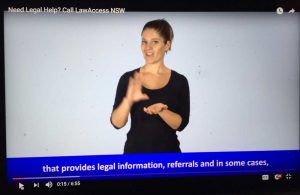
After Covering Captions
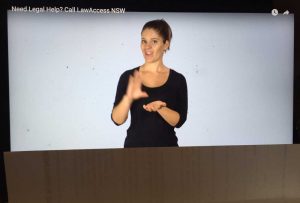
- Listen to the original translation or read the captioned English version. Compare this source to your interpretation in step 1. Note the areas that you were on target as well as the places where your interpretation diverged. What was happening in the video at those points? Does that fit with any patterns that you see in your work?
- Re-Interpret the video with the sound off and captions blocked. Try to incorporate what you learned from Step 2 in your new interpretation. (This is not cheating. This is an opportunity to practice fluency in our work.)
Working from English to AUSLAN:
- Interpret from English to AUSLAN: Listen to the English translation of the video, but don’t watch the AUSLAN version. Interpret this into AUSLAN. Again, it is best to record yourself to assist in analysis and reflection.
- Watch the original AUSLAN version. Compare this source to your interpretation in step 1. Note the areas that you were on target as well as the places where your interpretation diverged. What was happening in the video at those points? Does that fit with any patterns that you see in your work?
- Re-Interpret again using the English translation as source. Try to incorporate what you learned from Step 2 in your new interpretation. (This is not cheating. This is an opportunity to practice fluency in our work.)
The links below have a variety of topics explained in Auslan, with captioning and English translations. Videos formatted in this way are excellent opportunities to practice interpreting in a variety of ways.
These videos were created to be a part of workshops delivered by Doug in Australia
Source without Captions
Original Video (with English captions)
A Visit to Gallaudet
Thanks to Sherrie Beaver for her willingness to share this video. You can see more from Sherrie on her Facebook page, I Sign I Wander.
Visit to Gallaudet – English Translation
This translation was created by Jen Blyth. It is not designed to be the exemplary way to translate the source text, but one approach to be used as a resource for considering how you can create a more effective interpretation than your first attempt.
I am at Gallaudet University, wow, it is beautiful. Me and my friend Pip have had a tour of this university, and it is really beautiful. There is so much history here. Gallaudet is now 152 years old, so much history. I had a look at the buildings and met Gallaudet’s President, Bobbi, I forgot her last name. It was nice to meet her finally, she was a nice woman, we met coincidentally. We also saw the Deaf Space, wow, such an amazing concept. So much history, so many stories. We met an old man who told us about his experience at Gallaudet twenty or forty years ago. While on our tour we saw so many Deaf people around, socialising and talking. This is truly a Deaf space – a ‘Deaf Mecca’, truly wonderful. I always envisioned studying here one day, but I need money! Perhaps I should go to the bank or marry an American person! Look behind me…
A Visit to Gallaudet – Slow Motion
The video has been slowed down to provide a better opportunity for analysis and practice. (It is 80% speed of original video.)
Resources from the Deaf Society New South Wales
These video resources were created to share information in the Deaf community. Because they are formatted with both AUSLAN and English versions, they allow for interpreter skill development similar to practiced in the workshops.
http://deafsocietynsw.org.au/auslan_resources
Posted in: Auslan Resources
Storytelling Resources: AUSLAN – English
Fairytales from Auslan Storybooks
- Goldilocks and the Three Bears
- The Three Little Pigs
- Little Red Riding Hood
- The Gingerbread Man | Aussie Version
- Cinderella
Spoken English Versions
You can use these as a source text if you want to practice from English to AUSLAN – working to incorporate what you saw in the storytelling from Auslan Storybooks.
- Goldilocks and the Three Bears | Another version
- The Three Little Pigs
- Little Red Riding Hood
- The Gingerbread Man
- Cinderella
Posted in: Auslan Resources
Discourse Mapping – Auslan
This series of videos is designed to both learn about the features of discourse mapping and practice incorporating them in your work.
A Lesson on Weather and Climate in Australia
The video above was captioned for accessibility. The original video is at: https://youtu.be/QHn8YGdApOs
Lesson Plan for This Video
Objectives: Successful students will be able to:
- Identify the difference between weather and climate
- Compare and contrast Tropical and Temperate climate zones
- Explain the difference between weather and climate at Uluru in central Australia.


Example Video without Discourse Mapping
This video was created with an attempt to not have discourse mapping feature – which is a significant challenge.
Example Video with Discourse Mapping
This video was created with a more complete range of discourse mapping features.
Year 11 Lecture on Anatomy of a Neuron
You can see a similar process in this post with a lecture on the anatomy of a Neuron.
Posted in: Auslan Resources
Body Language – Auslan
 Body Language – Auslan Style
Body Language – Auslan Style
With the assistance of James Blyth and ASLIA Victoria, vicdeaf and Sign Language Video Productions, we have created a professional development module based on the CATIE Center at St. Catherine University’s successful series of Body Language modules.
The ASL Series has the following topics:
- The Cardiovascular System
- The Digestive System
- The Respiratory System
- The Muscular-Skeletal System
- Dealing with Diabetes
The Auslan version provides a sample activity from each of these 5 modules. Check it out here. We hope that this will be the start of a series of professional development opportunities that can be offered in Australia.
View “Body Language: Auslan” modules
Posted in: Auslan Resources
Parallel Texts – Auslan & English
The following texts are modeled after a resource created by Amy Williamson. She is a heritage signer, growing up with Deaf parents and natively speaking both ASL and English. You can check out Life in Parallel here. In addition, there is a free downloadable study packet entitled Analyzing Discourse. Though designed for an ASL – English resource, the same activities could easily be applied to Auslan-English work.
Australian Parallels
Gratitude to Julie Judd and Michelle Ashley for agreeing to create texts to model this process.
Introductions for Michelle
In this text, Michelle Ashley introduces herself in Auslan and shares some of her professional journey.
In this text, Michelle Ashley introduces herself in spoken English and shares some of her professional journey.
Introductions for Julie
In this text, Julie Judd introduces herself in spoken English and shares some of her professional journey.
In this text, Julie Judd introduces herself in Auslan and shares some of her professional journey.
Julie’s Favourite Thing
In this text, Julie explains in spoken English what her favourite pastime is.
In this text, Julie explains in Auslan what her favourite pastime is.
Michelle’s Favourite Thing
In this text, Michelle explains in spoken English what her favourite pastime is.
In this text, Michelle explains in Auslan what her favourite pastime is.
Posted in: Auslan Resources
Coyotes, Quidditch and Auslan
The following texts are designed to help incorporate narrative and depiction skills in Auslan. Thanks to James Blyth for sharing his storytelling talents.
Suggested Process
Based on Vygotskyan principles, use three steps.
- Create an Auslan explanation of the video clip. (Imagine that you are re-telling what you saw to a Deaf person.) If possible, video your Auslan version. Reflect on what parts went well and what sections were more challenging. Use that reflection to focus your attention in the second step.
- Watch Auslan example of how to convey the video clip. You may want to watch it more than once. On the second time, try copy signing or signing along with the signer to be able to not just see what the signer is doing, but physically incorporate some of the new ideas.
- Re-tell the video’s narrative in Auslan. Think about what you saw in Step 2. Work on incorporating features that you thought were particularly effective. Some might call this “stealing.” In professional development, we call this “learning.”
Talking About Coyotes
Source:
Auslan Example
Source:
Auslan Example
Posted in: Auslan Resources
7th Year Lecture: How the Bear Got Its Tail
This original video comes from a project called “Goats, Trolls and Numbskulls: A Middle School Lecture on Folklore Genres.” Thanks to James Blyth for sharing his talents in Auslan.
Suggestions
- For more background on Lise Lunge-Larsen, the lecturer, and the project as a whole, check out the original resource.
- For maximum benefit, use Vygotskyan framework of three step process:
- Work with object
- Work with Resource
- Work with Self
Source Lecture
Lise explains about this genre and tells the story of “How the Bear Got His Tail.”(3:46)
Auslan Interpretation
Posted in: Auslan Resources
11th Year Lecture: Anatomy of a Cell
This original video was created by a federal grant project. Thanks to James Blyth for sharing his talents in Auslan.
Suggestions
- For maximum benefit, use Vygotskyan framework of three step process:
- Work with object
- Work with Resource
- Work with Self
- Also take time to preview lesson
- Think about the significant features that can contribute to literacy
- Identification of key vocabulary that should be fingerspelled
- Consider what depiction strategies you might use
Preparation Material

Key Vocabulary
In a high school anatomy class, this lesson is focusing on helping students to understand the basic anatomy of a cells and how impulses are relayed within that structure. Included in the lesson are the key vocabulary of:
- cell body
- dendrites
- axon
Source Lecture
This excerpt of the lecture is 1:46.
Auslan Rendition without Discourse Mapping
This version was created for the purpose of showing how a lack of discourse mapping features contributes to a less intelligible text. Thanks for Karen Bontempo for doing the best job possible in removing those features. (As I shared at the workshop in Perth, Karen’s example here is of what not to do – which a participant came up to me and shared how ironic that is because Karen’s work is often lifted up as the model to follow. So grateful that she was also able to provide a model NOT to follow but to learn from in understanding the importance of discourse mapping features.) You can see more on Discourse Mapping in Auslan here.
Auslan Interpretation
See an ASL Version of this activity.
Posted in: Auslan Resources
Healthcare Resources
Here are some resources specific to interpreting in healthcare for Auslan.
- Video Resources from the NABS: This page has a series of videos related to Anatomy and different body systems. Some of the material is in both English and Auslan.
Posted in: Auslan Resources
Linguistics of Auslan
These three videos come from The Linguistics of Auslan page created by deaf CONNECTEd.
The videos use information drawn from the following text:
Johnston, T. & Schembri, A. (2007). Australian Sign Language: An introduction to sign language linguistics. Cambridge: Cambridge University Press.
Posted in: Auslan Resources
In Gratitude
Thanks to the ASLIA – SA branch and the Australian Association of Teachers of the Deaf (AATD – SA) for sponsoring this workshop.
Thanks to ASLIA-Victoria for their coordination in making it  possible, as well as the vicdeaf and their SLVP team that assisted with filming and editing of new Auslan resources.
possible, as well as the vicdeaf and their SLVP team that assisted with filming and editing of new Auslan resources.

